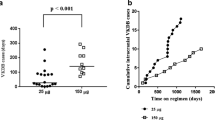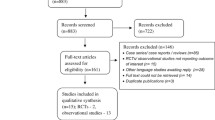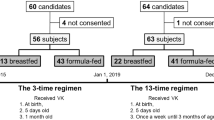Abstract
Oral and intramuscular Phytomenadione (vitamin K1) prophylaxis became an issue following the report of a potential carcinogenic effect of intramuscular but not oral Phytomenadione prophylaxis. There is increasing evidence, however, that oral Phytomenadione prophylaxis is less effective for the prevention of late vitamin K deficiency bleeding (VKDB) than intramuscular prophylaxis.
Following a report of an increased cancer risk after intramuscular phytomenadione, a series of papers on this issue appeared. Although an increased risk for solid tumours could almost certainly be excluded, a potential risk for acute lymphatic leukaemia in childhood could not be ruled out definitively.
Almost all cases of late VKDB are preventable with intramuscular phytomenadione prophylaxis administered once at birth, whereas a single oral dose given at birth is much less effective. Repeated oral Phytomenadione doses given to breast-fed infants either weekly (1mg) or daily (25μg) seem to be as effective as intramuscular Phytomenadione prophylaxis. The efficacy of 3 oral 2mg doses with the new mixed micellar preparation (‘Konakion MM’) remains to be established.
Although a number of studies have failed to confirm a cancer risk with phytomenadione, these studies have been unable to rule out a risk definitely because absence of evidence is not evidence of absence. A meta-analysis of the available studies might provide 95% confidence intervals narrow enough to exclude even a small cancer risk with some certainty. Oral prophylaxis will probably be as safe as the intramuscular prophylaxis if given daily (25μg) or weekly (1mg).
Similar content being viewed by others
References
von Kries R, Shearer MJ, Gobel U. Vitamin K in infancy. Eur J Pediatr 1988; 147(2): 106–12
Sutor AH, von Kries R, Cornelissen EAM, et al. Vitamin K deficiency bleeding (VKDB) in infancy. Thromb Haemost 1999; 81: 456–61
McNinch AW, L’Orme R, Tripp JH. Haemorrhagic disease of the newborn returns. Lancet 1983; I: 1089–90
von Kries R, Hanawa Y. Neonatal vitamin K prophylaxis. Report of Scientific and Standardization Subcommittee on Perinatal Haemostasis. Thromb Haemost 1993; 69(3): 293–5
Clark FI, James EJ. Twenty-seven years of experience with oral vitamin Kl therapy in neonates. JPediatr 1995; 127(2): 301–4
Jorgensen FS, Felding P, Vinther S, et al. Vitamin K to neonates. Peroral versus intramuscular administration. Acta Paediatr Scand 1991; 80(3): 304–7
Dargaville PA, Campbell NT. Overdose of ergometrine in the newborn infant: acute symptomatology and long-term outcome. J Paediatr Child Health 1998; 34(1): 83–9
Golding J, Greenwood R, Birmingham K, et al. Childhood cancer, intramuscular vitamin K, and pethidine given during labour. BMJ 1992; 305(6849): 341–6
McNinch AW, Tripp JH. Haemorrhagic disease of the newborn in the British Isles: two year prospective study. BMJ 1991; 303(6810): 1105–9
von Kries R, Gobel U. Vitamin K prophylaxis and vitamin K deficiency bleeding (VKDB) in early infancy. Acta Paediatr 1992; 81(9): 655–7
Ekelund H. Late haemorrhagic disease in Sweden 1987-89. Acta Paediatr Scand 1991; 80(10): 966–8
Tönz O, Schubiger G. Neonatale vitamin K prophylaxe und vitamin-K-Mangelblutungen in der Schweiz 1986-1988. Schweiz Med Wochenschr 1988; 118: 1747–52
McNinch AW, Upton C, Samuels M, et al. Plasma concentrations after oral or intramuscular vitamin Kl in neonates. Arch Dis Child 1985; 60(9): 814–8
Loughnan PM, McDougall PN. Does intramuscular vitamin Kl act as an unintended depot preparation? J Paediatr child Health 1996; 32(3): 251–4
Pietersma-de Bruyn AL, van Haard PM, Beunis MH, et al. Vitamin Kl levels and coagulation factors in healthy term newborns till 4 weeks after birth. Haemostasis 1990; 20(1): 8–14
Cornelissen EA, Kollee LA, De Abreu RA, et al. Effects of oral and intramuscular vitamin K prophylaxis on vitamin Kl, PIVKA-II, and clotting factors in breast fed infants. Arch Dis Child 1992; 67(10): 1250–4
Cornelissen EA, Kollee LA, De Abreu RA, et al. Prevention of vitamin K deficiency in infancy by weekly administration of vitamin K. Acta Paediatr 1993; 82(8): 656–9
Cornelissen EA, Kollee LA, van Lith TG, et al. Evaluation of a daily dose of 25 micrograms vitamin Kl to prevent vitamin K deficiency in breast-fed infants. J Pediatr Gastroenterol Nutr 1993; 16(3): 301–5
Cornelissen M, von Kries R, Loughnan P, et al. Prevention of vitamin K deficiency bleeding: efficacy of different multiple oral dose schedules of vitamin K. Eur JPediatr 1997; 156(2): 126–30
Norgaard-Hansen K, Ebbesen F. Neonatal vitamin K prophylaxis in Denmark: three years’ experience with oral administration during the first three months of life compared with one oral administration at birth. Acta Paediatr 1996; 85(10): 1137–9
Göbel U, Hachmeister A, von Kries R. Weniger späte Vitamin-K-Mangelblutungen. Kipra 1997; 68: 16–22
Schubiger G, Gruter J, Shearer MJ. Plasma vitamin Kl and PIVKA-II after oral administration of mixed-micellar or cremophor EL-solubilized preparations of vitamin Kl to normal breast-fed newborns. J Pediatr Gastroenterol Nutr 1997; 24(3): 280–4
Amedee-Manesme O, Lambert WE, Alagille D, et al. Pharmacokinetics and safety of a new solution of vitamin Kl(20) in children with cholestasis. J Pediatr Gastroenterol Nutr 1992; 14(2): 160–5
Golding J, Paterson M, Kinlen LJ. Factors associated with childhood cancer in a national cohort study. Br J Cancer 1990; 62: 304–8
Ekelund H, Finnstrom O, Gunnarskog J, et al. Administration of vitamin K to newborn infants and childhood cancer. BMJ 1993; 307(6896): 89–91
Klebanoff MA, Read JS, Mills JL, et al. The risk of childhood cancer after neonatal exposure to vitamin K. N Engl J Med 1993; 329(13): 905–8
Ansell P, Bull D, Roman E. Childhood leukaemia and intramuscular vitamin K: findings from a case-control study. BMJ 1996; 313(7051): 204–5
von Kries R, Gobel U, Hachmeister A, et al. Vitamin K and childhood cancer: a population based case-control study in Lower Saxony, Germany. BMJ 1996; 313(7051): 199–203
Zipursky A. Vitamin K at birth [editorial]. BMJ 1996; 313(7051): 179–80
McKinney PA, Juszczak E, Findlay E, et al. Case-control study of childhood leukaemia and cancer in Scotland: findings for neonatal intramuscular vitamin K. BMJ 1998; 316(7126): 173–7
Passmore SJ, Draper G, Brownbill P, et al. Ecological studies of relation between hospital policies on neonatal vitamin K administration and subsequent occurrence of childhood cancer. BMJ 1998; 316(7126): 184–9
Parker L, Cole M, Craft AW, et al. Neonatal vitamin K administration and childhood cancer in the north of England: retrospective case-control study. BMJ 1998; 316(7126): 189–93
Passmore SJ, Draper G, Brownbill P, et al. Case-control studies of relation between childhood cancer and neonatal vitamin K administration. BMJ 1998; 316(7126): 178–84
Author information
Authors and Affiliations
Corresponding author
Rights and permissions
About this article
Cite this article
von Kries, R. Oral Versus Intramuscular Phytomenadione. Drug-Safety 21, 1–6 (1999). https://doi.org/10.2165/00002018-199921010-00001
Published:
Issue Date:
DOI: https://doi.org/10.2165/00002018-199921010-00001




